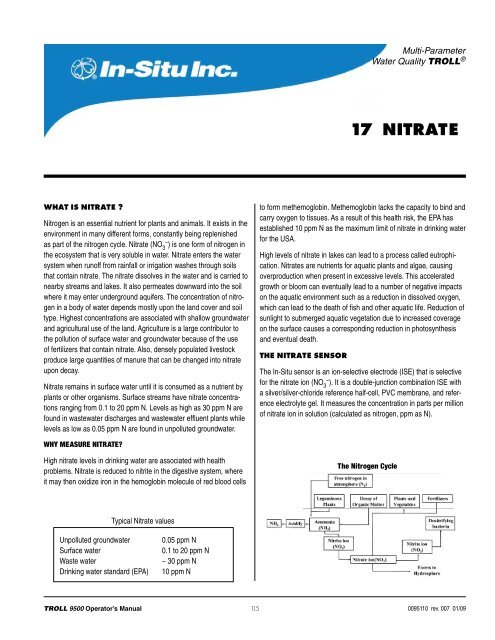TROLL 9500 Operator's Manual - Geotech Environmental Equipment
TROLL 9500 Operator's Manual - Geotech Environmental Equipment
TROLL 9500 Operator's Manual - Geotech Environmental Equipment
Create successful ePaper yourself
Turn your PDF publications into a flip-book with our unique Google optimized e-Paper software.
Multi-ParameterWater Quality <strong>TROLL</strong> ®17 NitrateWhat Is Nitrate ?Nitrogen is an essential nutrient for plants and animals. It exists in theenvironment in many different forms, constantly being replenishedas part of the nitrogen cycle. Nitrate (NO 3 – ) is one form of nitrogen inthe ecosystem that is very soluble in water. Nitrate enters the watersystem when runoff from rainfall or irrigation washes through soilsthat contain nitrate. The nitrate dissolves in the water and is carried tonearby streams and lakes. It also permeates downward into the soilwhere it may enter underground aquifers. The concentration of nitrogenin a body of water depends mostly upon the land cover and soiltype. Highest concentrations are associated with shallow groundwaterand agricultural use of the land. Agriculture is a large contributor tothe pollution of surface water and groundwater because of the useof fertilizers that contain nitrate. Also, densely populated livestockproduce large quantities of manure that can be changed into nitrateupon decay.Nitrate remains in surface water until it is consumed as a nutrient byplants or other organisms. Surface streams have nitrate concentrationsranging from 0.1 to 20 ppm N. Levels as high as 30 ppm N arefound in wastewater discharges and wastewater effluent plants whilelevels as low as 0.05 ppm N are found in unpolluted groundwater.Why Measure Nitrate?High nitrate levels in drinking water are associated with healthproblems. Nitrate is reduced to nitrite in the digestive system, whereit may then oxidize iron in the hemoglobin molecule of red blood cellsto form methemoglobin. Methemoglobin lacks the capacity to bind andcarry oxygen to tissues. As a result of this health risk, the EPA hasestablished 10 ppm N as the maximum limit of nitrate in drinking waterfor the USA.High levels of nitrate in lakes can lead to a process called eutrophication.Nitrates are nutrients for aquatic plants and algae, causingoverproduction when present in excessive levels. This acceleratedgrowth or bloom can eventually lead to a number of negative impactson the aquatic environment such as a reduction in dissolved oxygen,which can lead to the death of fish and other aquatic life. Reduction ofsunlight to submerged aquatic vegetation due to increased coverageon the surface causes a corresponding reduction in photosynthesisand eventual death.The Nitrate SensorThe In-Situ sensor is an ion-selective electrode (ISE) that is selectivefor the nitrate ion (NO 3 – ). It is a double-junction combination ISE witha silver/silver-chloride reference half-cell, PVC membrane, and referenceelectrolyte gel. It measures the concentration in parts per millionof nitrate ion in solution (calculated as nitrogen, ppm as N).The Nitrogen CycleTypical Nitrate valuesUnpolluted groundwaterSurface waterWaste waterDrinking water standard (EPA)0.05 ppm N0.1 to 20 ppm N~ 30 ppm N10 ppm N<strong>TROLL</strong> <strong>9500</strong> Operator’s <strong>Manual</strong> 1150095110 rev. 007 01/09
















